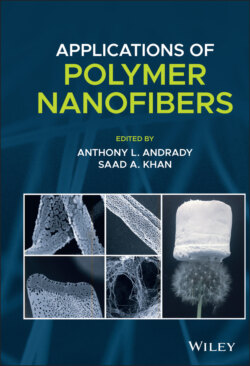Читать книгу Applications of Polymer Nanofibers - Группа авторов - Страница 49
2.5.3 Wearable Devices
ОглавлениеWearable devices are an attractive part of smart textiles. Wearable devices are known as electronic parts incorporated into clothing or accessories, which can collect and analyze information and data. Normally, wearable devices are lightweight and bendable. Benefited from the excellent flexibility and high surface area, nanofiber‐based materials are an excellent candidate for applications of wearable devices. Park et al. presented a sandwich structure of highly transparent electrospun keratin/PVA nanofiber embedded in textiles, which are used in polymer light‐emitting diodes (Park et al. 2016). Keratin was extracted from human hair and mixed with PVA, then electrospun into keratin/PVA nanofiber fabrics. After the “dip and dry” process, the obtained nanofiber fabrics were transparent. Then the fibers were sandwiched with electrodes and assistant layers, shown in Figure 2.18. After assembly, the optical and electrical analysis demonstrated that the devices were bendable and gave out lights of white, yellow, and red color. Gheibi et al. produced a one‐step nanogenerator by using piezoelectric electrospun PVDF nanofibers incorporating the electrodes within the structure of the device for use as self‐powering wearable electronics (Gheibi et al. 2014). The effect of deformation on the output voltage of the device was measured on the Keithley instrument by tapping, and a maximum peak of voltage output reached 1 V.
Figure 2.18 (a–f) Schematic illustration of assembling flexible PLEDs by using a sandwiched structure of keratin/PVA nanofiber nonwoven fabric/polymer light‐emitting diodes (s)/keratin/PVA nanofiber nonwoven fabric.
Source: Reproduced with permission from Park et al. (2016). Copyright 2016, Elsevier.
